Japan-United States of America Relations
Japan-U.S. Summit Meeting
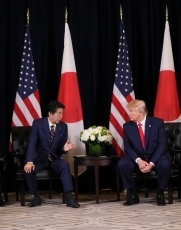 Photograph of the Japan-U.S. Summit Meeting
Photograph of the Japan-U.S. Summit Meeting(expanded meeting)
(Photo: Cabinet Public Relations Office)
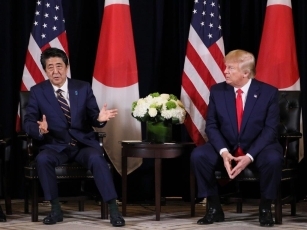 Photograph of the Japan-U.S. Summit Meeting
Photograph of the Japan-U.S. Summit Meeting (expanded meeting)
(Photo: Cabinet Public Relations Office)
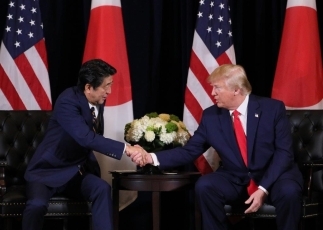 Photograph of the Japan-U.S. Summit Meeting
Photograph of the Japan-U.S. Summit Meeting (expanded meeting)
(Photo: Cabinet Public Relations Office)
On September 25, commencing at around 12:00 p.m. (local time), the signing ceremony of the Japan-U.S. Joint Statement was held for approximately 20 minutes, followed by the Japan-U.S. Summit Meeting between Mr. Shinzo Abe, Prime Minister of Japan, who was visiting the United States, and the Honorable Donald J. Trump, President of the United States of America, commencing at around 12:20 p.m. for approximately 70 minutes. The overview of the meeting is as follows.
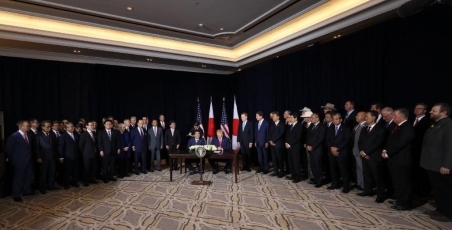 Photograph of the Japan-U.S. Summit Meeting (signing ceremony)
Photograph of the Japan-U.S. Summit Meeting (signing ceremony)
(Photo: Cabinet Public Relations Office)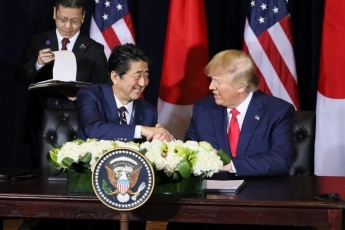 Photograph of the Japan-U.S. Summit Meeting (signing ceremony)
Photograph of the Japan-U.S. Summit Meeting (signing ceremony)
(Photo: Cabinet Public Relations Office)
1. The leaders reaffirmed the recognition that the Japan-U.S. Alliance is stronger than ever before as it marks their fifth Summit Meeting this year alone, including the visit to Japan by President Trump and Mrs. Trump as the first State Guests in the era of Reiwa in this May, this year alone, and shared the view on continuing to further strengthen the unwavering Japan-U.S. Alliance.
2. Regarding the Japan-U.S. trade negotiations, the two leaders confirmed that the both sides reached final agreement on the Japan-United States Trade Agreement and the Japan-United States Digital Trade Agreement, and issued the Joint Statement (English (PDF) / Japanese (PDF)
/ Japanese (PDF) ).
).
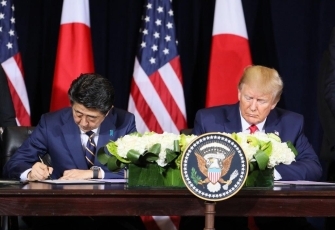 Photograph of the Japan-U.S. Summit Meeting (signing ceremony)
Photograph of the Japan-U.S. Summit Meeting (signing ceremony)
(Photo: Cabinet Public Relations Office)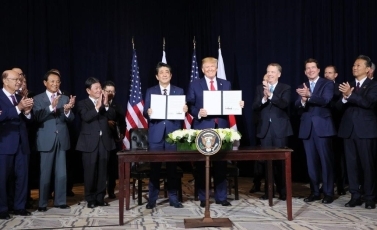 Photograph of the Japan-U.S. Summit Meeting (signing ceremony)
Photograph of the Japan-U.S. Summit Meeting (signing ceremony)
(Photo: Cabinet Public Relations Office)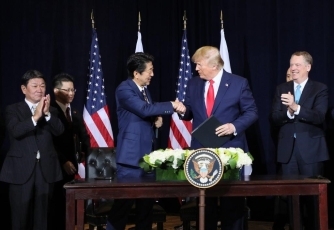 Photograph of the Japan-U.S. Summit Meeting (signing ceremony)
Photograph of the Japan-U.S. Summit Meeting (signing ceremony)
(Photo: Cabinet Public Relations Office)
3. Furthermore, Prime Minister Abe explained to President Trump that investment by Japanese companies in the United States has been contributing to the expansion of U.S. employment, including the facts that since the inauguration of the Trump Administration, investment of a cumulative total of 25.7 billion dollars in the U.S. has been announced, that over 50,000 jobs have been created, and that Japan has become the largest investor in the U.S. In response, President Trump expressed his great appreciation.
4. Moreover, the leaders exchanged views on the situation on North Korea, including issues of concern such as the abductions, nuclear, and missiles issues, and confirmed that Japan and the United States, as well as Japan, the United States, and the Republic of Korea would continue to closely cooperate on these issues.
5. The leaders shared the view that Japan and the United States would continue to cooperate toward easing tensions and stabilizing the situation in the Middle Eas t. In relation to this, the two leaders strongly criticized the recent attacks on the crude oil facilities in Saudi Arabia. Prime Minister Abe stated that in light of the capabilities of the Houthis it was difficult to conclude that these attacks had been carried out by the Houthis, while Japan has been undertaking information gathering and analysis to evaluate this incident, and would continue to work together with the countries concerned, including the United States.
6. Furthermore, Prime Minister Abe said that the previous day he had called on President Rouhani to ensure that Iran exercised self-restraint to ease the situation and to ensure that Iran exercised its influence constructively. Prime Minister Abe also said that he intended to work closely with the United States to bring about peace and stability in the Middle East.

